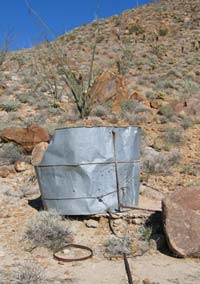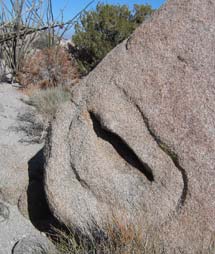Harper Flat, Anza-Borrego 

We'd
been looking forward to the long Thanksgiving weekend. The
reason was Harper Flat. This large, bowl-shaped valley nestled
high in the Vallecito Mountains is certainly one of the least visited
areas of the park. However, in the past, Harper Flat was the
site of the largest Indian camps in the Anza Borrego region. Could
we find evidence of these ancient Indians? Come on along with
us and find out!
 We arrived
in Borrego Springs Friday morning and spent some time checking out
the great books at the visitor
center. Then it was time to
gas up and head toward Fish Creek south of Ocotillo Wells. The
drive up Fish Creek Wash is always magical. If you only do
one off road jaunt in the park let it be this one. You'll wind
through Split Mountain Gorge, pass by the famous anticline and the
wind caves, see the elephant knees, check out the multi-colored layer
cake, cross the entrance to Sandstone Canyon and finally
climb your way up to Hapaha Flat. This road is for high
clearance four wheel drive vehicles. You won't have much traffic! We
arrived at our campsite near McCain Spring in the afternoon and had
enough time to hike up to the spring itself. Just start at
the old water tank and follow the rusting pipe up to the spring. You'll
do a lot of boulder scrambling, but the area is scenic and has lots
of plant life. Also, lots of animal life! We found a
4 1/2 inch long cougar print in the wash! The spring is dry now, but there are still remnants of it in the form of an old shaft covered by wood planks. We stayed away from this area, not knowing how solid it was. On the hillside near the old shaft is an area covered over by plastic tarps held in place by rocks. This device acts as a guzzler to catch and channel rainwater to the two prominent storage tanks. We opened the access panels to find
that both were full. A thoughtful touch is a small metal
trough that birds and bees were busy enjoying. This general McCain
Spring area is reputed to have had an Indian camp. In
our exploring we found ample evidence that this is true. Pottery
pieces, obsidian chips, and fragments of bone from birds and rabbits
all underscored the fact that Hapaha Flat was a popular bit of real
estate. At 3,000 feet, our campsite for the night was a bit
on the cool side. We turned in early. We had already found evidence
of one Indian camp. Would we be as lucky tomorrow in Harper
Flat? As we drifted off to sleep a full moon lit
up our camp to a remarkable degree. This was fine by us,
because we kept remembering those cougar tracks!
We arrived
in Borrego Springs Friday morning and spent some time checking out
the great books at the visitor
center. Then it was time to
gas up and head toward Fish Creek south of Ocotillo Wells. The
drive up Fish Creek Wash is always magical. If you only do
one off road jaunt in the park let it be this one. You'll wind
through Split Mountain Gorge, pass by the famous anticline and the
wind caves, see the elephant knees, check out the multi-colored layer
cake, cross the entrance to Sandstone Canyon and finally
climb your way up to Hapaha Flat. This road is for high
clearance four wheel drive vehicles. You won't have much traffic! We
arrived at our campsite near McCain Spring in the afternoon and had
enough time to hike up to the spring itself. Just start at
the old water tank and follow the rusting pipe up to the spring. You'll
do a lot of boulder scrambling, but the area is scenic and has lots
of plant life. Also, lots of animal life! We found a
4 1/2 inch long cougar print in the wash! The spring is dry now, but there are still remnants of it in the form of an old shaft covered by wood planks. We stayed away from this area, not knowing how solid it was. On the hillside near the old shaft is an area covered over by plastic tarps held in place by rocks. This device acts as a guzzler to catch and channel rainwater to the two prominent storage tanks. We opened the access panels to find
that both were full. A thoughtful touch is a small metal
trough that birds and bees were busy enjoying. This general McCain
Spring area is reputed to have had an Indian camp. In
our exploring we found ample evidence that this is true. Pottery
pieces, obsidian chips, and fragments of bone from birds and rabbits
all underscored the fact that Hapaha Flat was a popular bit of real
estate. At 3,000 feet, our campsite for the night was a bit
on the cool side. We turned in early. We had already found evidence
of one Indian camp. Would we be as lucky tomorrow in Harper
Flat? As we drifted off to sleep a full moon lit
up our camp to a remarkable degree. This was fine by us,
because we kept remembering those cougar tracks! Split
Rock is only a short drive further west from McCain Spring. Saturday
morning found us shouldering our packs and heading north along the
wash that runs from Split Rock through a low pass and into Harper
Flat. It's a relatively easy hike. We enjoyed seeing
two owls hustle off as we approached their tree, a dragonfly, some
pegmatite dikes and sprays of black schorl, desert lavender attended
by a host of bees, and other diversions. Soon we were in Harper
Flat itself. Hiking here would not be easy. There is
no such thing as a straight line. The flat is choked with agaves
and cactus. Washes twist and turn and disappear, leaving you to try
to pierce the maze of the flat like a sailboat tacking against the
wind. Big jackrabbits burst from cover under our feet and again
reminded us of the cougar tracks. However, hard work and a
bit of serendipity led us to a most amazing spot. Amidst a
jumble of rocks we found morteros. Not just a couple, but well
over twenty! Fragments of pottery littered the ground. Some
of those fragments were huge. We even found the intact spout
portion of one piece. Nearby we found two yonis that were a
combination of naturally occurring slits in rocks and hand carving
to enhance the semblance of the powerful fertility symbol of the
vaginal entrance. The trip was a success. However, we
already have identified another part of the flat that we want to
look into, but that will have to wait. As the sun dropped behind
Whale Peak we straggled back to Split Rock. Nothing was taken
from the site but pictures and memories. If you find it, please
leave it in the same condition. We exited Fish Creek Wash as
the sun set and decided to camp there. Tomorrow we would head
for home after checking out the "herd" of elephant trees that resides
in that area. We had a wonderful time. The thrill of
discovery is addictive. We'll be back! Click below to
see some of the photos from this trip.
Split
Rock is only a short drive further west from McCain Spring. Saturday
morning found us shouldering our packs and heading north along the
wash that runs from Split Rock through a low pass and into Harper
Flat. It's a relatively easy hike. We enjoyed seeing
two owls hustle off as we approached their tree, a dragonfly, some
pegmatite dikes and sprays of black schorl, desert lavender attended
by a host of bees, and other diversions. Soon we were in Harper
Flat itself. Hiking here would not be easy. There is
no such thing as a straight line. The flat is choked with agaves
and cactus. Washes twist and turn and disappear, leaving you to try
to pierce the maze of the flat like a sailboat tacking against the
wind. Big jackrabbits burst from cover under our feet and again
reminded us of the cougar tracks. However, hard work and a
bit of serendipity led us to a most amazing spot. Amidst a
jumble of rocks we found morteros. Not just a couple, but well
over twenty! Fragments of pottery littered the ground. Some
of those fragments were huge. We even found the intact spout
portion of one piece. Nearby we found two yonis that were a
combination of naturally occurring slits in rocks and hand carving
to enhance the semblance of the powerful fertility symbol of the
vaginal entrance. The trip was a success. However, we
already have identified another part of the flat that we want to
look into, but that will have to wait. As the sun dropped behind
Whale Peak we straggled back to Split Rock. Nothing was taken
from the site but pictures and memories. If you find it, please
leave it in the same condition. We exited Fish Creek Wash as
the sun set and decided to camp there. Tomorrow we would head
for home after checking out the "herd" of elephant trees that resides
in that area. We had a wonderful time. The thrill of
discovery is addictive. We'll be back! Click below to
see some of the photos from this trip.
